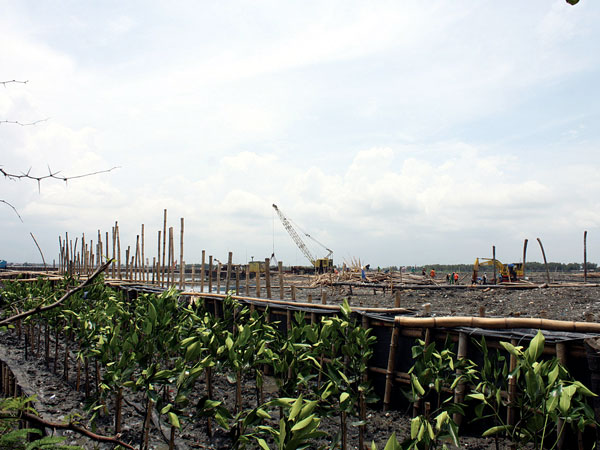Landfill site unused as one more is built

MANGROVES line the embankments of the landfill being built on the coast of Obando, Bulacan. TONETTE OREJAS/INQUIRER CENTRAL LUZON
Last of two parts
OBANDO, Bulacan—The Supreme Court’s order for Bulacan to help in the cleanup of Manila Bay is being defied or ignored by several local governments in the province.
For instance, only six of 24 local governments dispose of their solid wastes in one of two landfills operating in the uplands of Bulacan.
The towns of San Rafael, Bulacan, Baliuag and Sta. Maria and the cities of Meycauayan and San Jose del Monte use a 40-hectare landfill operated by VGP company. The landfill is located in San Jose del Monte City.
Not one local government uses an 8-ha landfill operated by Wacuman, another firm, in Norzagaray town.
Article continues after this advertisementThis happens although Presidential Proclamation No. 1655 of former President Gloria Macapagal-Arroyo authorized Wacuman to accept trash from Bulacan, Metro Manila and nearby provinces.
Article continues after this advertisementLormelyn Claudio, Environmental Management Bureau (EMB) director in Central Luzon, said the agency’s last monitoring showed that Bocaue and Guiguinto towns use the Rodriguez landfill in Rizal province; Obando town, the Philippine Ecology Systems Corp. landfill in Navotas City; and Plaridel and Pulilan towns, the Metro Clark landfill in Tarlac.
Norzagaray runs its own landfill in Barangay Matictic but Mayor Feliciano Legaspi said the facility needed improvement. Legaspi said the local government had spent P40 million to operate the facility in the last seven years.
Doña Remedios Trinidad town is trying to make its materials recovery facility (MRF) work, matching that with a composting project.
Calumpit town is giving the bulk of its recovered plastics to Holcim Philippines for cement-making, said Claudio.
The City of Malolos and Hagonoy, Paombong, Angat, Balagtas, Bustos, Marilao, Pandi, San Ildefonso and San Miguel towns still use open dumps in violation of the Ecological Solid Waste Management Act of 2000 (Republic Act No. 9003), she said.
The local governments of these try to make MRFs work in the villages to no avail, she said. Malolos runs its own central segregation facility.
Some local governments have resorted to burying their residual wastes, like sanitary pads and diapers on vacant lots.
“It has become usual that after we order the closure of a dump this week, we would get reports that it is opened after a week or two,” said lawyer Rustico de Belen, provincial environment and natural resources officer.
Managing wastes is not just a matter of political will but also of resources, De Belen said. With several priorities, he said local governments managed to set aside only
1 or 2 percent of their annual budget to solid waste management.
Based on EMB’s estimate that every person generates half a kilogram of waste daily, Bulacan’s more than two million residents could generate 1.4 million kg of waste a day.
The provincial government estimated that to be equivalent to 793.13 cubic meters or 59 10-wheel trucks a day.
San Jose del Monte Mayor Reynaldo San Pedro said the city spends P25 to P30 million yearly for solid waste management. “It is sad that we spend that much on wastes so we have been exploring waste-to-energy schemes,” he said.
Commitment
The Ecoshield Development Corp. (EDC) entered into an agreement in October last year with the local government to help Bulacan heed the high court directive for the province to help clean up Manila Bay through its landfill.
Claudio said she approved the project in 2010 hoping it would be “more beneficial for Bulacan and Central Luzon.”
However, the environmental clearance certificate (ECC) issued by Claudio to EDC approved a “sanitary landfill for domestic wastes only.”
She ordered EDC not to build anything beyond a 10-hectare area that she identified in the ECC.
The Concerned Citizens of Obando (CCO) questioned the location of the Obando landfill and the processes its construction went through with Department of Environment and Natural Resources agencies.
The Supreme Court, after issuing a writ of kalikasan, tossed to the Court of Appeals the petition of CCO to issue a temporary environment protection order.
The Obando landfill sits close to Metro Manila, where on a day alone, the Metropolitan Manila Development Authority pays an average of P5.4 million per day to dispose of the capital region’s wastes, estimated at 9,000 metric tons every day, in four sites, an industry source said.